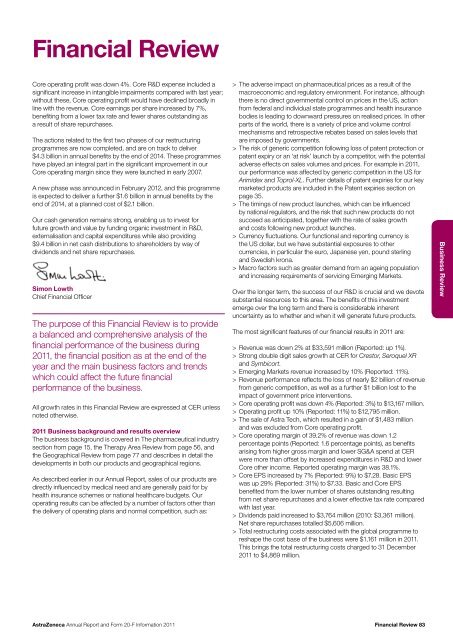AstraZeneca Annual Report and Form 20-F Information 2011
AstraZeneca Annual Report and Form 20-F Information 2011
AstraZeneca Annual Report and Form 20-F Information 2011
- No tags were found...
You also want an ePaper? Increase the reach of your titles
YUMPU automatically turns print PDFs into web optimized ePapers that Google loves.
Financial ReviewCore operating profit was down 4%. Core R&D expense included asignificant increase in intangible impairments compared with last year;without these, Core operating profit would have declined broadly inline with the revenue. Core earnings per share increased by 7%,benefiting from a lower tax rate <strong>and</strong> fewer shares outst<strong>and</strong>ing asa result of share repurchases.The actions related to the first two phases of our restructuringprogrammes are now completed, <strong>and</strong> are on track to deliver$4.3 billion in annual benefits by the end of <strong>20</strong>14. These programmeshave played an integral part in the significant improvement in ourCore operating margin since they were launched in early <strong>20</strong>07.A new phase was announced in February <strong>20</strong>12, <strong>and</strong> this programmeis expected to deliver a further $1.6 billion in annual benefits by theend of <strong>20</strong>14, at a planned cost of $2.1 billion.Our cash generation remains strong, enabling us to invest forfuture growth <strong>and</strong> value by funding organic investment in R&D,externalisation <strong>and</strong> capital expenditures while also providing$9.4 billion in net cash distributions to shareholders by way ofdividends <strong>and</strong> net share repurchases.Simon LowthChief Financial OfficerThe purpose of this Financial Review is to providea balanced <strong>and</strong> comprehensive analysis of thefinancial performance of the business during<strong>20</strong>11, the financial position as at the end of theyear <strong>and</strong> the main business factors <strong>and</strong> trendswhich could affect the future financialperformance of the business.All growth rates in this Financial Review are expressed at CER unlessnoted otherwise.<strong>20</strong>11 Business background <strong>and</strong> results overviewThe business background is covered in The pharmaceutical industrysection from page 15, the Therapy Area Review from page 56, <strong>and</strong>the Geographical Review from page 77 <strong>and</strong> describes in detail thedevelopments in both our products <strong>and</strong> geographical regions.As described earlier in our <strong>Annual</strong> <strong>Report</strong>, sales of our products aredirectly influenced by medical need <strong>and</strong> are generally paid for byhealth insurance schemes or national healthcare budgets. Ouroperating results can be affected by a number of factors other thanthe delivery of operating plans <strong>and</strong> normal competition, such as:> The adverse impact on pharmaceutical prices as a result of themacroeconomic <strong>and</strong> regulatory environment. For instance, althoughthere is no direct governmental control on prices in the US, actionfrom federal <strong>and</strong> individual state programmes <strong>and</strong> health insurancebodies is leading to downward pressures on realised prices. In otherparts of the world, there is a variety of price <strong>and</strong> volume controlmechanisms <strong>and</strong> retrospective rebates based on sales levels thatare imposed by governments.> The risk of generic competition following loss of patent protection orpatent expiry or an ‘at risk’ launch by a competitor, with the potentialadverse effects on sales volumes <strong>and</strong> prices. For example in <strong>20</strong>11,our performance was affected by generic competition in the US forArimidex <strong>and</strong> Toprol-XL. Further details of patent expiries for our keymarketed products are included in the Patent expiries section onpage 35.> The timings of new product launches, which can be influencedby national regulators, <strong>and</strong> the risk that such new products do notsucceed as anticipated, together with the rate of sales growth<strong>and</strong> costs following new product launches.> Currency fluctuations. Our functional <strong>and</strong> reporting currency isthe US dollar, but we have substantial exposures to othercurrencies, in particular the euro, Japanese yen, pound sterling<strong>and</strong> Swedish krona.> Macro factors such as greater dem<strong>and</strong> from an ageing population<strong>and</strong> increasing requirements of servicing Emerging Markets.Over the longer term, the success of our R&D is crucial <strong>and</strong> we devotesubstantial resources to this area. The benefits of this investmentemerge over the long term <strong>and</strong> there is considerable inherentuncertainty as to whether <strong>and</strong> when it will generate future products.The most significant features of our financial results in <strong>20</strong>11 are:> Revenue was down 2% at $33,591 million (<strong>Report</strong>ed: up 1%).> Strong double digit sales growth at CER for Crestor, Seroquel XR<strong>and</strong> Symbicort.> Emerging Markets revenue increased by 10% (<strong>Report</strong>ed: 11%).> Revenue performance reflects the loss of nearly $2 billion of revenuefrom generic competition, as well as a further $1 billion lost to theimpact of government price interventions.> Core operating profit was down 4% (<strong>Report</strong>ed: 3%) to $13,167 million.> Operating profit up 10% (<strong>Report</strong>ed: 11%) to $12,795 million.> The sale of Astra Tech, which resulted in a gain of $1,483 million<strong>and</strong> was excluded from Core operating profit.> Core operating margin of 39.2% of revenue was down 1.2percentage points (<strong>Report</strong>ed: 1.6 percentage points), as benefitsarising from higher gross margin <strong>and</strong> lower SG&A spend at CERwere more than offset by increased expenditures in R&D <strong>and</strong> lowerCore other income. <strong>Report</strong>ed operating margin was 38.1%.> Core EPS increased by 7% (<strong>Report</strong>ed: 9%) to $7.28. Basic EPSwas up 29% (<strong>Report</strong>ed: 31%) to $7.33. Basic <strong>and</strong> Core EPSbenefited from the lower number of shares outst<strong>and</strong>ing resultingfrom net share repurchases <strong>and</strong> a lower effective tax rate comparedwith last year.> Dividends paid increased to $3,764 million (<strong>20</strong>10: $3,361 million).Net share repurchases totalled $5,606 million.> Total restructuring costs associated with the global programme toreshape the cost base of the business were $1,161 million in <strong>20</strong>11.This brings the total restructuring costs charged to 31 December<strong>20</strong>11 to $4,869 million.Business Review<strong>AstraZeneca</strong> <strong>Annual</strong> <strong>Report</strong> <strong>and</strong> <strong>Form</strong> <strong>20</strong>-F <strong>Information</strong> <strong>20</strong>11Financial Review 83










